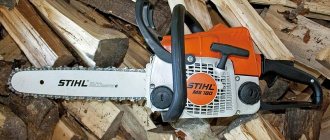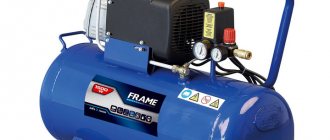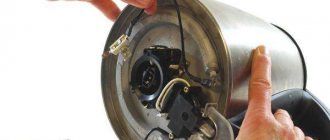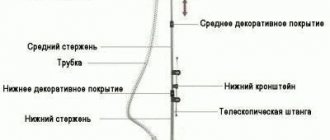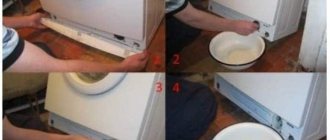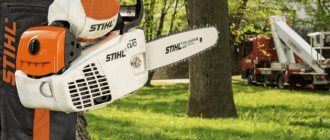The main reasons for chainsaw failure
Although the chain saw is a simple device, from time to time problems arise in its operation, which can only be eliminated by disassembling it. Examples include the following faults:
- the chainsaw does not gain speed;
- the chainsaw stops functioning when cutting;
- the chainsaw starts and stalls;
- the chainsaw loses its power;
- The chainsaw stalls when pressed.
Most often, malfunctions are associated with interruptions in the functioning of the motor, as well as with malfunctions of other systems and components. Proper handling of this equipment is of great importance. If all the rules of use are followed, problems with a high probability lie in the most obvious ones. When looking for the causes of problems, it is advisable to start by checking the simplest part of the chainsaw and finish with the most complex.
Checking the main chainsaw systems
If the chainsaw refuses to work normally, you need to make sure that all the conditions required for its normal functioning are provided:
Then you need to sequentially check the functioning of all its elements. First you need to check the fuel tank. If the reason is not the volume or quality of the fuel, then the likely cause of the malfunction may be the spark plugs. The spark plug gap should not exceed 0.5 millimeters. If it is too small, this means that carbon deposits have deposited on the candles. In this case, you should remove the spark plugs, clean them, then put them back in place and try to start the chainsaw. In addition, it is advisable to completely replace the spark plugs with new ones from time to time, even if they are in good condition.
Then you need to check the condition of the fuel filter and carburetor. Cleaning the fuel filter yourself is not a difficult task, but carburetor repair is best left to specialists.
The chainsaw starts and stalls - the reason
If the chainsaw starts and stalls during the first attempts to do the job, then the reason may be problems with the chain brake or its jamming due to lack of lubrication. In this case, measure the oil level. If the amount of lubricant is sufficient, then the reason may lie in the tube that leads it to the lubrication mechanism.
Another reason could be a carburetor failure. If it only needs adjustment, you can do it yourself according to the instructions. If the carburetor needs cleaning or repair, then you cannot do without the help of professionals.
Another possible cause of this malfunction is a low fuel level in the tank. In this case, the chain saw stalls when tilted, since the remainder of the fuel mixture ends up in the part of the tank opposite to the place where the suction tube is located.
What to do if the chainsaw does not idle?
Problems with idle speed are considered constant companions of chainsaws. There may be several prerequisites that could lead to stalling at the time of start-up and cranking of the chain when idling, the main ones being:
- air and gasoline filters are clogged;
- poor quality fuel mixture or improper preparation;
- problems with the ignition module;
- a carburetor whose settings no longer correspond to the load on the saw;
- motor elements are deformed or rusted.
A series of actions are performed sequentially:
- wash the fuel hose or replace it with a new one,
- Clean the air filter, which could be clogged with sawdust and dirt particles. Modern air filters are reusable, they can be washed with the addition of detergent, completely removing them from the saw body;
- check gasoline and motor oil, which may be of poor quality or simply not suitable for working with this saw;
- testing spark plugs and carburetor.
Eliminating one or more possible problems will usually restore the saw to its former strength.
Why does a chainsaw stall when heating up?
It often happens that the chainsaw starts when cold, but stalls when it warms up. This behavior of the tool can be caused by the following reasons:
- The carburetor is not adjusted correctly. This problem can be identified by how the device starts up when cold. If it is carried out without closing the air damper, and the engine starts without a preliminary flash, this means that after the engine warms up, fuel floods the spark plug. The solution to this problem is to adjust the carburetor. Details about carburetor adjustment
- Malfunction of the coil (ignition module). This problem can be identified by sequentially checking the spark, first on a cold and then on a hot engine. If there is no spark on a hot engine, then you need to replace the ignition coil.
- Spark plug faulty. In this situation, as in the case of a faulty ignition module, the spark disappears when the engine heats up. You need to replace the spark plug with a new one, and if this does not solve the problem, you should check the ignition module and the distance between it and the flywheel.
Incorrect carburetor setting
This is perhaps the main reason why a chainsaw stalls when hot. Diagnosis is quite simple: when starting on a cold chainsaw, it starts with the throttle open without the first short-term flash. Let me remind you that when starting correctly when cold, you need to close and pull the starter until the engine tries to start and stalls immediately after that. Only after this the valve needs to be opened and the chainsaw will start up in operating mode.
So, if the chainsaw still starts right away without first pulling the starter with the damper closed until the first preliminary flash, then this means that initially enough fuel mixture is supplied so that the chainsaw is immediately ready for work without preheating, and then during warming up it occurs expansion of the fuel supply channels, due to which the gasoline mixture begins to flow in too large quantities and simply floods the spark plug, since the fuel does not have time to completely burn.
Therefore, carburetor adjustment is required, in which it is necessary to slightly reduce the supply of gasoline mixture. This is done by rotating the corresponding screws, marked with the letters H and L, which are accessible from the surface of the saw body. On household models there is sometimes only one screw.
You can make the adjustment by eye yourself, but it is better to contact a service center, since precise adjustment requires special equipment, which the average user, as a rule, does not have.
What to do if the chainsaw stalls when you press the gas
In addition, this malfunction may be associated with a defect in the fuel tank breather. Due to the formation of a vacuum in the fuel tank during the operation of the chain saw, the required volume of the fuel mixture does not enter the engine, as a result of which it cannot gain speed or stalls. If you stop the chainsaw, open and close the fuel tank and turn it on again, it will work normally for about five minutes, and then again stop picking up speed or stall.
Another possible reason that the chain saw is not able to gain speed may be excess carbon deposits in the muffler, which makes it difficult for exhaust gases to escape, which reduces engine power and speed.
Add a comment Cancel reply
You must be logged in to post a comment.
Owners of chainsaws sometimes have to deal with the fact that the saw, for no apparent reason, stops working normally. In our article we will try to figure out why the chainsaw stalls in various operating modes, as well as describe how the malfunction can be diagnosed.
Why does a chainsaw stall when heating up?
The situation in which a chainsaw starts up when cold, but may stall while warming up, is familiar to many who deal with them. The main reasons for this behavior of the saw are as follows.
- The ignition module (coil) is faulty. You can determine the malfunction by checking the spark first on a cold engine, and then on a hot one. If there is no spark on a hot engine, then you should try to fix the problem by replacing the ignition coil.
- The chainsaw carburetor is not set correctly (fills the spark plug hot). You can determine the problem by how the saw starts when cold. If for a cold start it is not necessary to close the air damper, and the engine starts without a preliminary flash, then the fuel mixture is not formed correctly and after the engine warms up, the fuel floods the spark plug and makes starting impossible. The problem is eliminated by adjusting the carburetor.
- The spark plug is faulty. In such a situation, similar to a faulty ignition coil, the spark disappears when the engine heats up. It is worth trying to replace the spark plug with a new one, and if this does not help, then you need to check the ignition coil and the gap between it and the flywheel.
You can check the ignition coil using a multimeter or by replacing it with a known good one. Checking the primary and secondary windings with a multimeter is carried out in resistance measurement mode. The resistance of the primary winding, the working coil, is 1 kOhm - the secondary is 4 kOhm.
Spark plug fault
It is logical to assume that it is very easy to diagnose this problem if you have the opportunity to test the spark plug on another chainsaw that is known to be working. If another chainsaw stalls with this spark plug, then that means the problem is there.
In this case, you can consider yourself lucky, since this is the easiest and most inexpensive option for returning the chainsaw to working condition. New spark plugs are inexpensive and easy to change.
Thus, we looked at three main reasons why a chainsaw stalls when hot. Just do the above diagnostic measures and calmly find out the cause. And with this I will allow myself to finish this text - thank you for your attention and see you in other articles.
Why does a chainsaw stall under load?
In some cases, the chainsaw is unable to work normally when under load and simply stalls. A common reason for this behavior is improper carburetor adjustment, or air leakage through the crankshaft seals or carburetor gasket. This behavior can also occur due to a leak in the carburetor.
It is best to diagnose the cause and eliminate the fact that the chainsaw starts and stalls under load at a service center, since a special tool is needed to check the tightness of the carburetor and engine crankcase.
A saw that is unable to operate under load will also be unable to maintain idle speed. They will "float". Diagnostics begins with checking the crankcase and carburetor for leaks. If air leaks are detected through the crankshaft seals, they must be replaced. If air leaks are detected in the carburetor, the cause can be eliminated by installing a repair kit of gaskets.
Chainsaw engine malfunctions
The engine is the main component of the chainsaw, and most of the breakdowns that occur in it are associated with the gasoline drive. Correct diagnostics can determine the causes and troubleshooting methods even for an untrained user.
The main problems with starting the engine may be the following:
- the engine does not start;
- works unsteadily;
- startup occurs, after which the unit immediately stalls;
- stalls under load.
Ignition system malfunctions
First of all, the reason that the chainsaw does not start must be looked for in the ignition system of the unit. You need to start by checking the spark plug, since there is a possibility that the spark has disappeared.
By the state of the unscrewed spark plug, you can determine how the fuel system works. The spark plug is unscrewed with a special key.
The following figure shows 3 possible spark plug conditions.
A spark plug splashed with fuel indicates an excess of fuel in the cylinder. If the spark plug is flooded, then most likely the carburetor is incorrectly adjusted, or the rules for starting the engine were violated. The candle must be thoroughly wiped and dried. You should also drain the combustion chamber:
- shut off the fuel supply;
- With the spark plug unscrewed, pull the starter several times to remove all gasoline from the cylinder:
- Reinstall the spark plug and adjust the carburetor according to the instructions.
A large amount of soot on the spark plug is caused by an incorrect ratio between oil and gasoline during preparation of the fuel mixture, as well as problems in the fuel supply system. If the mixture is prepared correctly, using high-quality oil, then the carburetor should be adjusted. A spark plug with carbon must be cleaned by rinsing it in gasoline. After that, you need to wipe it dry, remove any remaining burnt residue with a needle, and clean the electrodes with fine sandpaper.
You should also check the spark plug for the correct gap between the electrodes. Normally, the spark plug gap should be in the range from 0.5 to 0.65 mm.
If the spark plug is dry, you need to check for a spark at its electrodes to rule out a malfunction of the ignition system.
- Place the cap with the high-voltage cable on the spark plug.
- Holding the cap, attach the spark plug threads to the cylinder.
- Pull the starter handle several times and see if a spark jumps between the electrodes. Normally, the spark should be bright. A weak spark indicates a possible problem with the ignition coil or the spark plug itself.
If there is a spark, then the problem needs to be looked for in the fuel system. There is no spark - the reason may lie in the spark plug itself (needs to be replaced) or the ignition system. The absence of a spark may cause a damaged cable, which should be checked by “ringing” the tester. If the wire is in good condition, you need to move on - check the ignition module. A malfunction of the ignition coil or an incorrectly set gap between it and the magnet can also cause the spark to disappear.
Ignition on a chainsaw is simple: a permanent magnet is attached to the motor shaft. A coil is fixed near it under a certain gap. When the magnet rotates, an electric current is generated in the coil, which is supplied to the electrodes of the spark plug. In the next photo the arrow shows where the correct gap between the coil and the magnet is set.
The gap between these parts should be 0.2-0.4 mm. The walls of a regular plastic bottle have this thickness, and you can make a template (probe) from it by cutting off a small strip.
The gap is set as follows:
- unscrew the screws holding the coil;
- place a template between the magnet and the coil;
- lightly press the coil against the magnet;
- tighten the coil mounting screws and remove the template.
Fuel system malfunctions
If the chainsaw does not start well, and everything is in order with the ignition system, then it is necessary to check the entire fuel system of the unit. First of all, you need to adjust the supply of the fuel mixture to the engine cylinder through the carburetor by setting it correctly.
Next, you need to observe how the chainsaw behaves.
- The device stalls after starting. If you prepare the fuel mixture incorrectly, adding more oil to it than required, the unit will immediately stall or run only on suction.
- The engine stalls at idle. This is a sign of a muffler clogged with carbon deposits (needs to remove carbon deposits), a clogged air filter (needs to be washed), or incorrect carburetor settings.
- The unit stalls at maximum speed. The fuel or air filter is dirty and needs to be cleaned thoroughly. Often this engine behavior can be caused by a clogged gas tank breather. It is cleaned with a regular needle. In addition, a malfunction of the membrane, which acts as a fuel pump, may also prevent the engine from reaching maximum speed. You will need to disassemble the carburetor and replace the membrane if it has lost elasticity.
- The chainsaw stops working under load. This is a sign of improper carburetor adjustment, improperly prepared mixture, or a dirty air filter.
- Fuel pumping does not work. If the primer does not pump gasoline, and this happens most often after a long break in the operation of the unit, then you need to check the carburetor. What the primer looks like and where it is located on a Husqvarna chainsaw is shown in the following photo.
There is a spray valve inside the carburetor that can stick if fuel is left around it for a long time. To eliminate the malfunction, you need to thoroughly rinse the carburetor with gasoline or flushing fluid, and then blow out all the holes with compressed air. - The chainsaw does not start when hot. If you turn off the chainsaw and after a short period of time unsuccessfully try to start it, then in most cases this is caused by a loss of compression in the piston group.
Compression is checked with a compression gauge, which is screwed into the cylinder instead of a spark plug. Next, you need to pull the starter and observe the instrument readings. Normally, a new chainsaw shows compression ranging from 8 to 12 atmospheres. If the reading is below 8 atmospheres, the engine will not work.
Compression may be lost due to scratches on the inside of the cylinder and the side surface of the piston. In this case, you will have to change the entire piston group.
Why does the chainsaw not pick up speed and stalls?
If the chainsaw is unable to gain speed a minute after starting or stalls when the gas trigger is pressed, most likely the carburetor or engine crankcase is leaking. As in the previous case, the problem can be solved by checking for leaks and adjusting the carburetor.
If your chainsaw does not pick up speed and stalls after it has been running normally for about 5 minutes, the cause may be a defective fuel tank breather. The vacuum created in the fuel tank during operation of the tool does not allow the engine to receive the necessary amount of fuel for its normal operation, and for this reason it will be unable to gain speed or stall. In this case, if you stop the tool, open and close the fuel tank cap and start the chainsaw again, the tool will again work normally for about five minutes, after which it will stop picking up speed or stall.
The reason that the chainsaw does not pick up speed may also be excessive carbon deposits in the muffler, which makes it difficult to release exhaust gases, thereby reducing engine power and speed.
If you want to check the tightness of the crankcase, but do not have a special tool, you can use the following testing method.
Algorithm for checking the crankcase for leaks
- Remove the side cover and bar from the chainsaw.
- Unscrew the spark plug and insert a string with knots into the cylinder through the spark plug hole, thereby stopping the movement of the piston and crankshaft.
- You can use an old cord from a starter as a cord with knots, tying knots on it every 3-5 cm.
- Unscrew the chainsaw drive sprocket.
- Remove the oil pump cover and the pump itself.
- Remove the starter from the chainsaw.
- Unscrew and remove the flywheel.
- Remove the carburetor.
- Using a syringe, pour gasoline into the crankcase through the hole under the carburetor in the cylinder, while observing the crankshaft seals. If gasoline flows through them, it means the seals have become unusable and need to be replaced with new ones.
- It is better to entrust the installation of oil seals to professionals.
An indirect sign of crankcase leakage is oil leaks in the area of the seals.
Chainsaw chain problems
In addition to problems with the engine, the chainsaw may experience operational problems due to a malfunction of the cutting (sawing) unit, consisting of an oil pump, bar and saw chain.
There is no oil getting to the tire
Usually, if oil does not flow to the chainsaw chain, you need to check the channels through which oil is supplied to the tire and clean them of dirt. If the previous steps did not reveal the cause of the problem, then you will have to check the oil pump. To do this you need:
- remove part of the chainsaw casing;
- remove the coupling;
- unscrew the 3 screws and remove the cover hiding the pump;
- get to the worm gear gear that rotates the pump shaft.
If the thread on it is worn out, the shaft does not rotate, the pump does not work, and the chain is not lubricated. A worn gear needs to be replaced. You can also remove the oil pump itself and manually try to pump oil through it. If it does not pump, the pump should be replaced.
Chainsaw oil filter
Be sure to remove the oil filter from the reservoir and clean it if necessary.
Also, a lack of lubricant may be due to its leakage. You should check how tightly the pipes coming from the oil pump are connected. If the tightness is broken, the tubes are replaced with new ones.
The chain breaks
If the chain breaks while the chainsaw is running, this could happen when it hits a hard object, such as a nail. If the chain constantly breaks, then the reasons may be the following.
- Low quality of the metal from which the saw chain is made. It is necessary to buy gas cutter saws from reputable brands.
- Chain overheating due to poor lubrication. As a result, the saw overheats, the properties of the metal change, and it breaks under load. It is necessary to check the entire chainsaw lubrication system (discussed above).
You can also learn about the reasons for frequent circuit breaks from this video.
The chain doesn't turn
This nuisance often plagues inexperienced chainsaw owners. They forget to remove the brake after starting the engine. As a result, the chain does not spin, the brake system overheats, and the clutch mechanism fails. The problem is solved by removing the saw from the brake. If the clutch is not burnt out, you will notice the chain turning. Otherwise, the clutch mechanism will need to be replaced.
The chain gets dull quickly
Basically, the reason that the chain becomes dull quickly is the poor quality of the saw. Trying to save money on buying branded chains, chainsaw owners buy saws from unknown manufacturers, or, due to inexperience, purchase counterfeits of well-known brands. It is best to buy a cutting element for a gas cutter in company stores. Stihl saw chains are very popular among owners of this equipment.
The chain doesn't stop
If, when working with a chainsaw, you notice that the saw chain does not stop at the right moment, then this breakdown may have 2 options.
- The brake band is dirty. When operating the saw, dirt, sawdust, dust, etc. may get under the band. As a result, the brake mechanism becomes blocked and the chain does not stop when the gas is released. The problem is eliminated by cleaning this unit.
- The brake band is worn out. This element of the brake system needs to be replaced.
The chain is jammed
This happens when the drive or driven sprocket wears out. The chain usually starts to jam under load. But without load the saw can rotate. The photo below shows a worn chainsaw drive sprocket.
The next photo shows that the reason why the chain jams must be looked for at the location of the driven sprocket.
But what to do if the chainsaw is completely jammed, and all attempts to pull the starter are unsuccessful? This malfunction sometimes occurs on Chinese-made chainsaws. It is caused by the bolts that screw the engine to the plastic casing of the unit becoming loose due to vibration. These bolts are located directly under the flywheel (magneto). In the photo below, arrows show the location of the problem bolts.
As they unscrew, they begin to rub against the flywheel and can completely jam the chainsaw. The following photo shows the flywheel with some scuff marks from the bolts.
To fix the problem, you will need to remove the flywheel from the engine shaft and tighten the bolts.
The chainsaw cuts crookedly
This problem can occur if the chain is dull or improperly sharpened. This applies to a greater extent to new chainsaws. But if the tire is worn out, then even after replacing the chain you will notice that the saw is pulled to the side. Tire wear can be easily determined by placing it on a level table and applying a square to it, as shown in the following photo.
In this case, you can see that there is a gap of about 2 mm between the tire and the corner. It is because of this one-sided tire wear that the chainsaw cuts crookedly. The problem can only be solved by replacing the tire with a new one.
Important: to extend the life of the chainsaw bar, it must be removed and turned over from time to time. Thanks to this, the tire will wear more evenly and will not cause chain misalignment.
Malfunctions leading to improper operation of the chainsaw
There are a number of malfunctions that must be taken into account when diagnosing, since they can lead to interruptions in the operation of the saw.
- Wear of crankshaft bearings. If the crankshaft bearings are worn out, runout will inevitably appear on the main shaft where the flywheel is attached. In such a situation, it is impossible to adjust the gap between the flywheel and the ignition coil, which leads to interruptions in spark formation and unstable operation of the chainsaw.
- Impulse channel is dirty. The pulse channel serves to ensure the operation of the fuel pump; accordingly, its contamination will lead to improper operation of the pump, which will make it impossible for the saw to operate (it will start and immediately stall).
- CPG wear. As a rule, with increased wear of the CPG, a decrease in compression in the chainsaw engine is observed, which will certainly affect its ability to develop speed.
- Dirty fuel and air filters.

